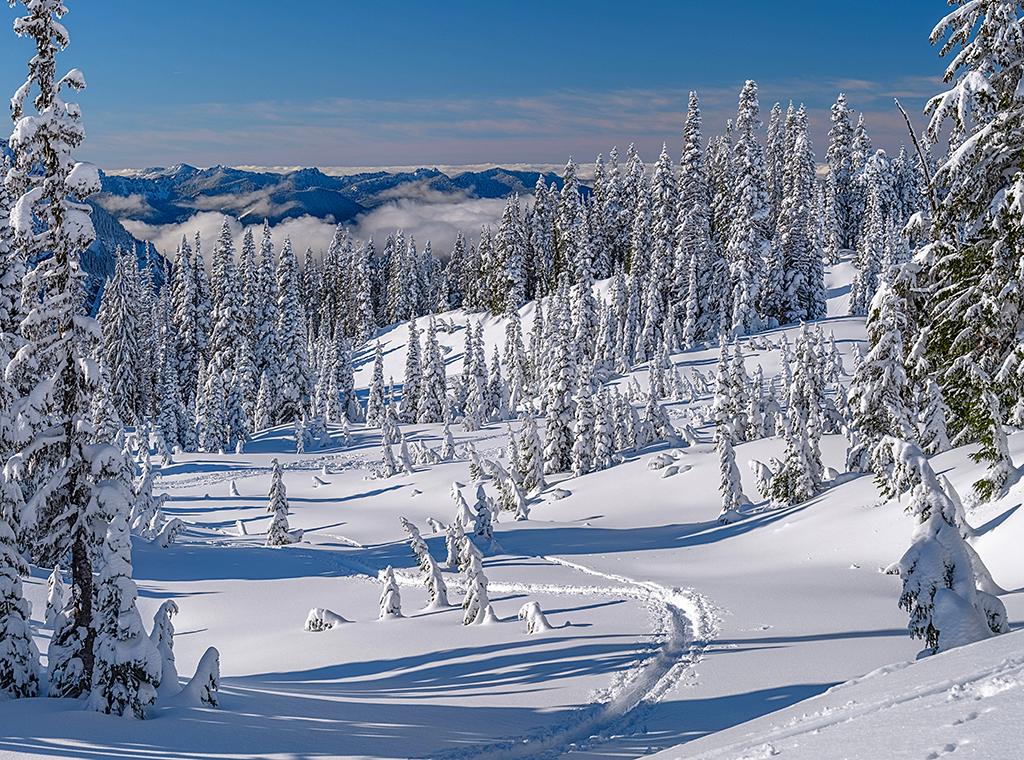Mount Rainier National Park in Washington State is open year-round. Visit this park during different seasons of the year, and the landscape will look totally different, from wildflower-carpeted meadows during spring and summer, to huckleberry bushes painted in bright autumn hues of orange and red in the higher elevations, to 50 feet (15 m) of snow and closed roads during the winter months.
Spring

During the spring, snow and ice still cover the Reflection Lakes area, Mount Rainier National Park / Rebecca Latson
Spring in this national park – particularly in the upper elevations – occurs at a much later date than in the surrounding landscape. Much of this national park will still be covered in snow during March through May. Paradise Inn will still be snowbound until its usual May opening date, and the road to Sunrise won’t even be open until sometime in July. Upper-elevation trails will still be blanketed in snow, but lower elevations such as the Longmire area will be snow-free but wet and rainy. It might be wise to bring along snowshoes or cross-country skis so you don’t find yourself “postholing” (sinking your legs into deep snow with each step) during your walk on the snow. Remember to pack warm clothing for those park forays, too.
You will know it’s officially spring at Mount Rainier when you see the skunk cabbage in bloom, along with trillium and coltsfoot in late June. Throughout July and into early August, glacier lilies and avalanche lilies emerge with the melting snow. Varieties of paintbrush and lupine also start popping up in July, especially in the park’s Paradise and Sunrise areas.

Dew-dappled avalanche lilies, Mount Rainier National Park / Rebecca Latson

Scarlet paintbrush, Mount Rainier National Park / Rebecca Latson
Other wildflowers such as beargrass, tiger lilies, penstemon, monkeyflower, spirea, and other varieties really gear up mid-July through early August.
There are three main ecological zones within the national park, each with different wildflowers blooming at certain times within these life zones:
- Forest zone (1,700 – 5,000 feet / 518.16 – 1,524 meters) – white flowers, yellow/orange flowers, red/pink flowers
- Subalpine zone (5,000 – 7,000 feet / 1,524 – 2,133.6 meters) – blue/purple flowers, white flowers, yellow/orange flowers, red/pink flowers
- Alpine zone (7,000 – 14,410 feet / 2,133.6 – 4,392.17 meters)
You can download the Subalpine Wildflowers bulletin of the most commonly-seen flowers in the park.
You can also check for updates on what wildflowers happen to be blooming at the time of your visit.
Summer

A summer reflection of "The Mountain," Mount Rainier National Park / Rebecca Latson
This is peak visitation season at Mount Rainier. From late July through early September, the trails are free of snow and, for the most part, the skies are clear, the days are sunny, and it’s the driest and warmest time of year. The weather can change in a moment’s notice, however, and within the space of minutes, that sunshine can give way to overcast skies and chilly wind and rain shower during your hike. Also, don’t forget even during the summer, the upper elevations will be cold during the nights and mornings.

A long line of cars waiting to drive through the White River/Sunrise entrance, Mount Rainier National Park / Rebecca Latson
Summertime is also a time of congestion in the park, with long lines of cars waiting at the entrances, few available parking spaces, and solidly-booked park lodging and camping. In 2024, a pilot timed-entry reservation system was implemented, for which the park is currently seeking public feedback. Depending upon the feedback, you may see this reservation system again in 2025, so be prepared.
Autumn

Fall color at sunrise in the Paradise area, Mount Rainier National Park / Rebecca Latson
If you are looking for color, you’ve got it with autumn’s bright orange and red huckleberry bushes in the high elevations. Vine maple and larch also provide a punch of bright color. Longmire-area temperatures will range between 68oF – 45oF (20oC – 7oC) and Paradise temps can run 57oF – 41oF (14oC – 5oC) on average. Remember to dress accordingly.

Average monthly temperatures in Mount Rainier National Park / NPS file
Winter

A winter scene at Paradise, Mount Rainier National Park / Rebecca Latson
It can snow over 600 inches (50 ft / 15 m) during a winter in the high elevations of Paradise (and Sunrise, too, although that area is closed to vehicles during that time). Lower elevations may also experience snow and ice around Longmire, but more often, it’s an icy rain. Remember your vehicle’s tire chains (required to carry in your car whenever it begins snowing heavily in the park) and bring some traction devices for your boots. Prepare for cold, rainy, snowy weather on any given day.
Once the snow has blanketed the landscape, the crowds lessen and solitude envelopes the park. Sledding, snowshoeing, skiing, and winter photography take center stage at Mount Rainier. All the roads are closed apart from the Nisqually-to-Paradise Corridor, and sometimes the road from Longmire up to Paradise is closed due to road conditions. It’s always a good idea to check out the webcams for a look at the landscape on the day you wish to visit.
Click here to access the park’s weather page and list of weather-related links, and go on over to take a look at the park’s annual snowfall totals from 1920 – 2023.





